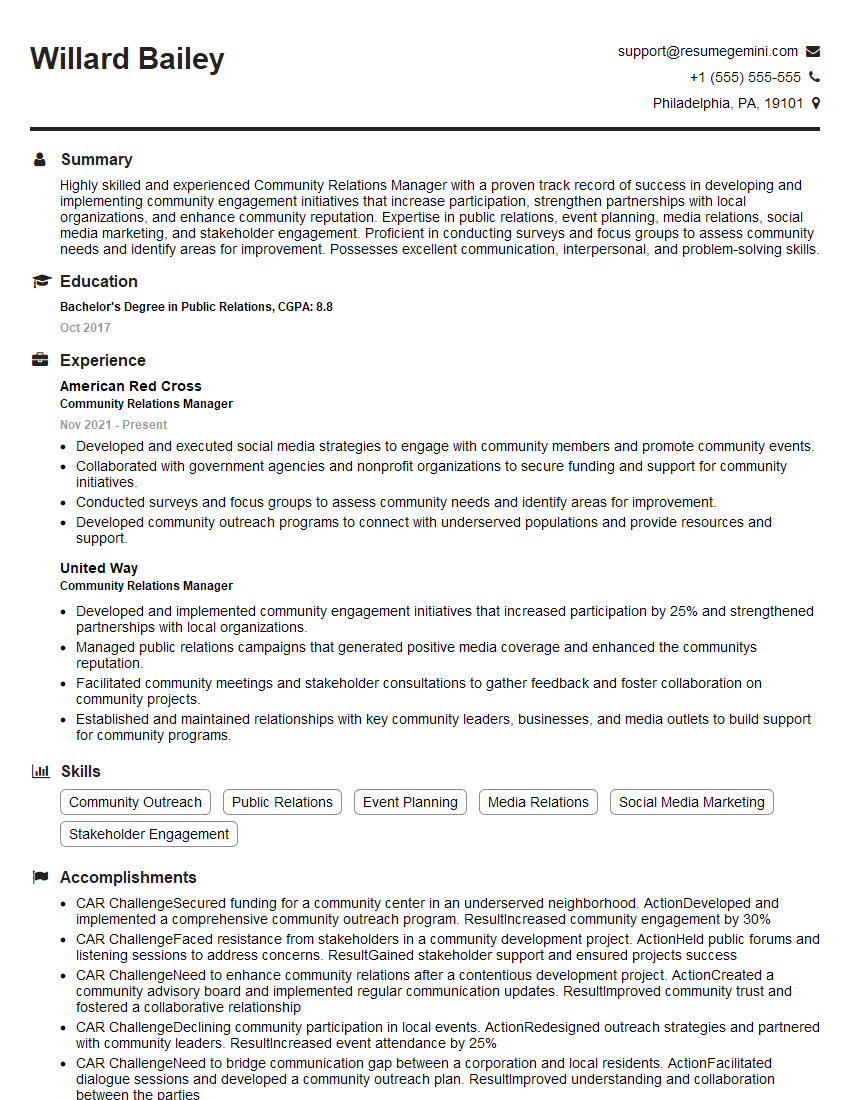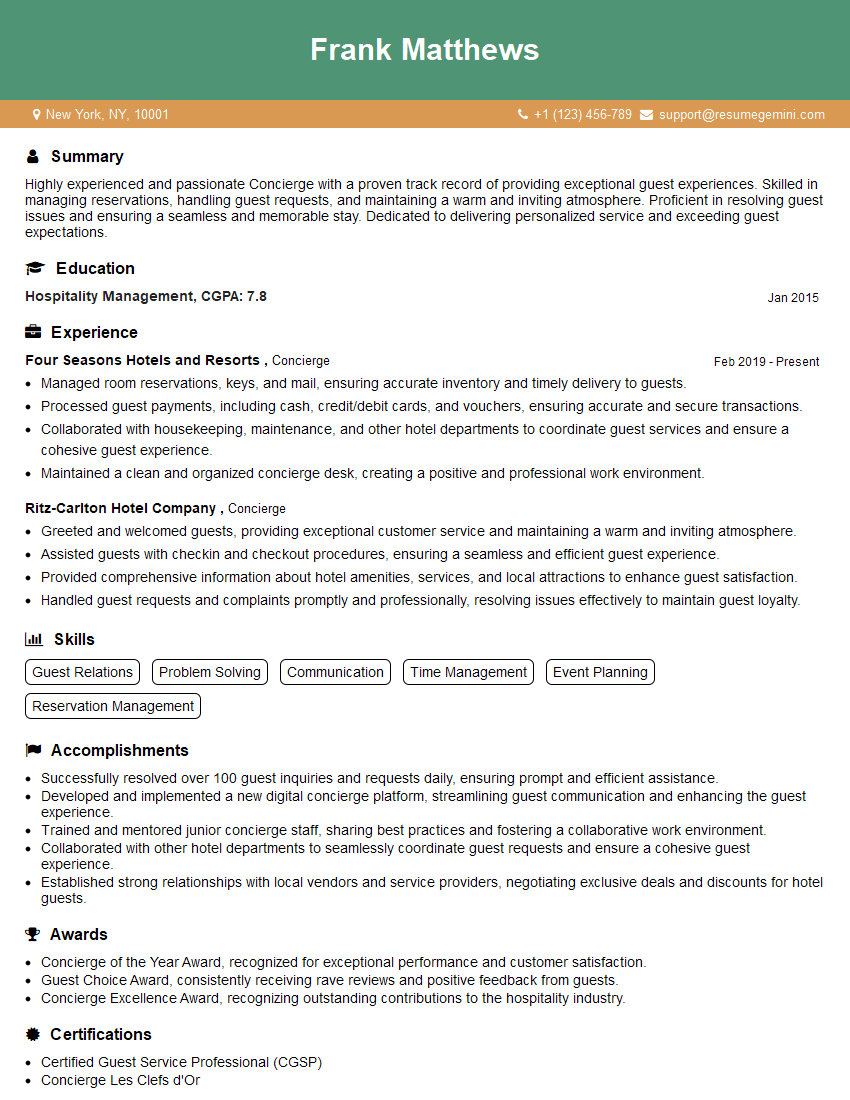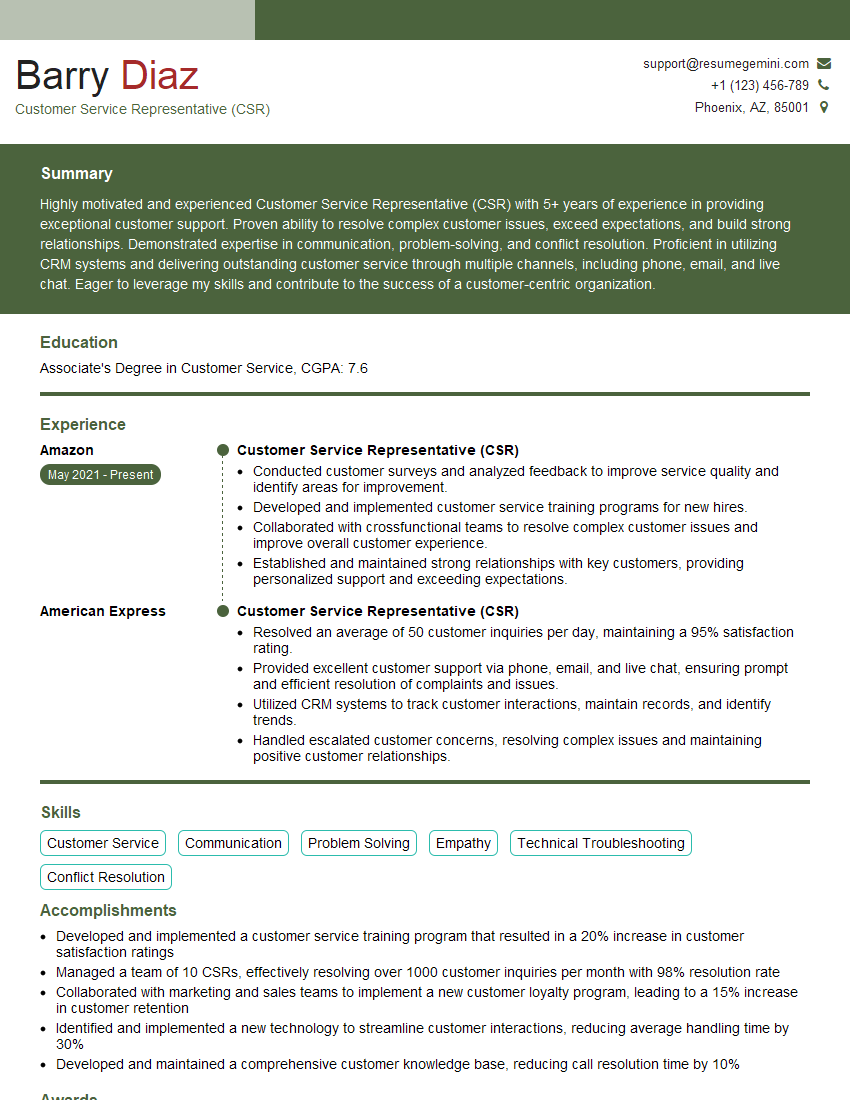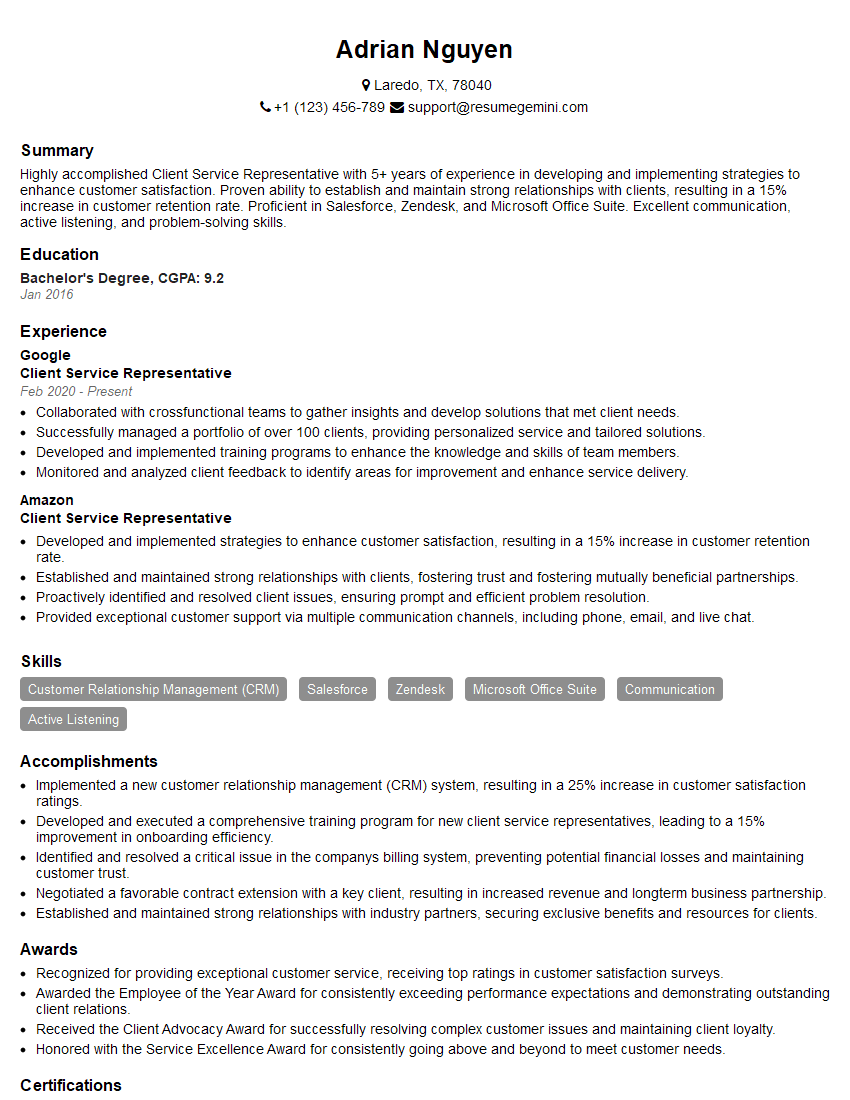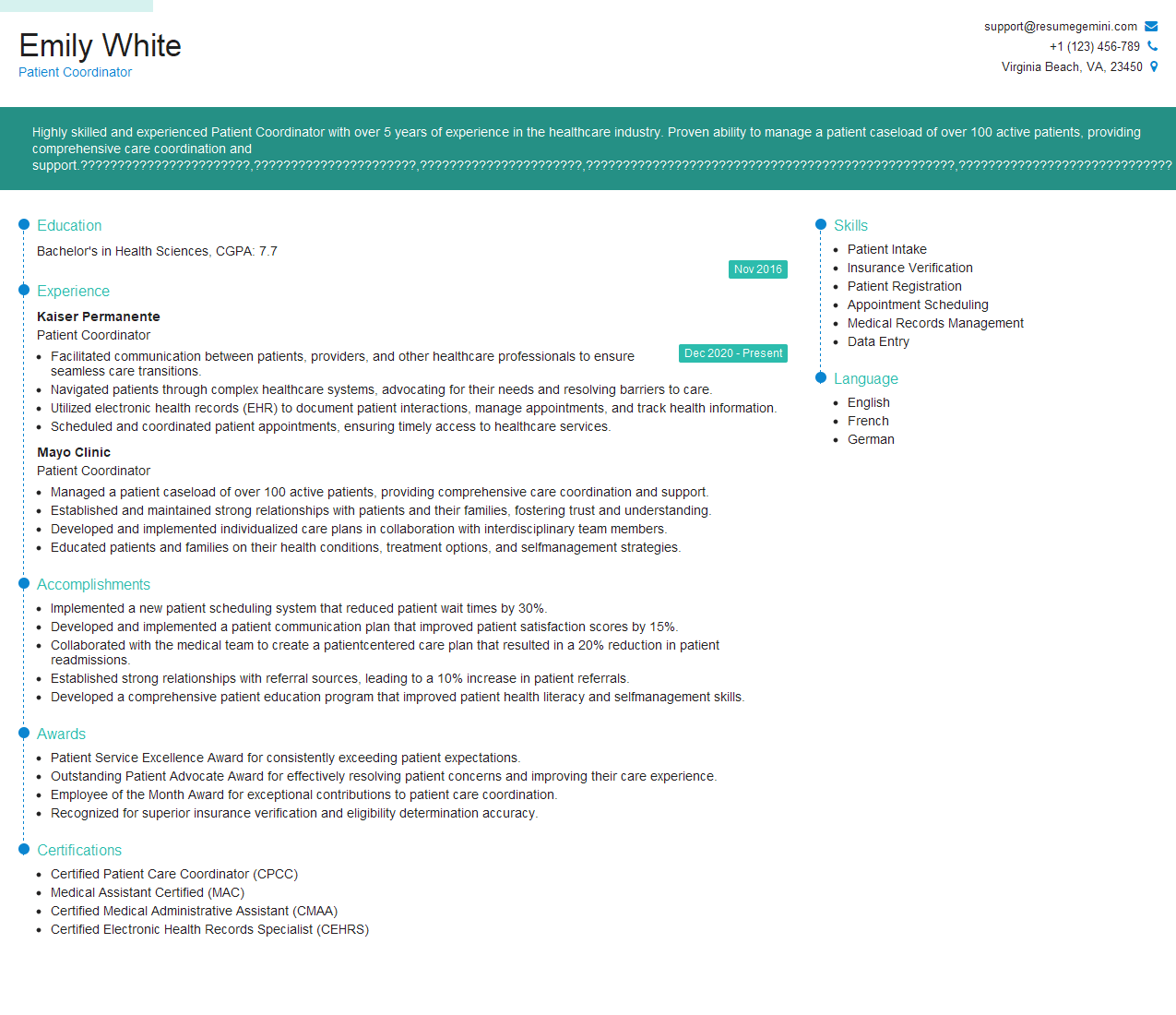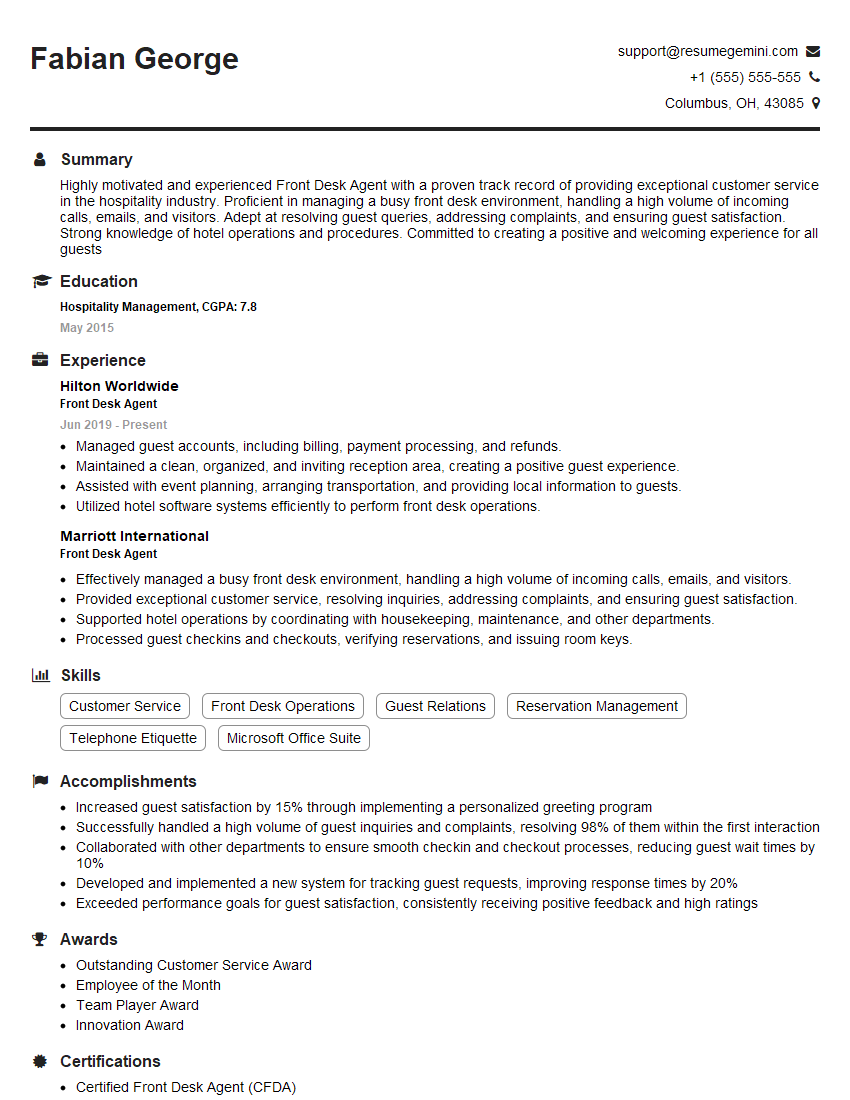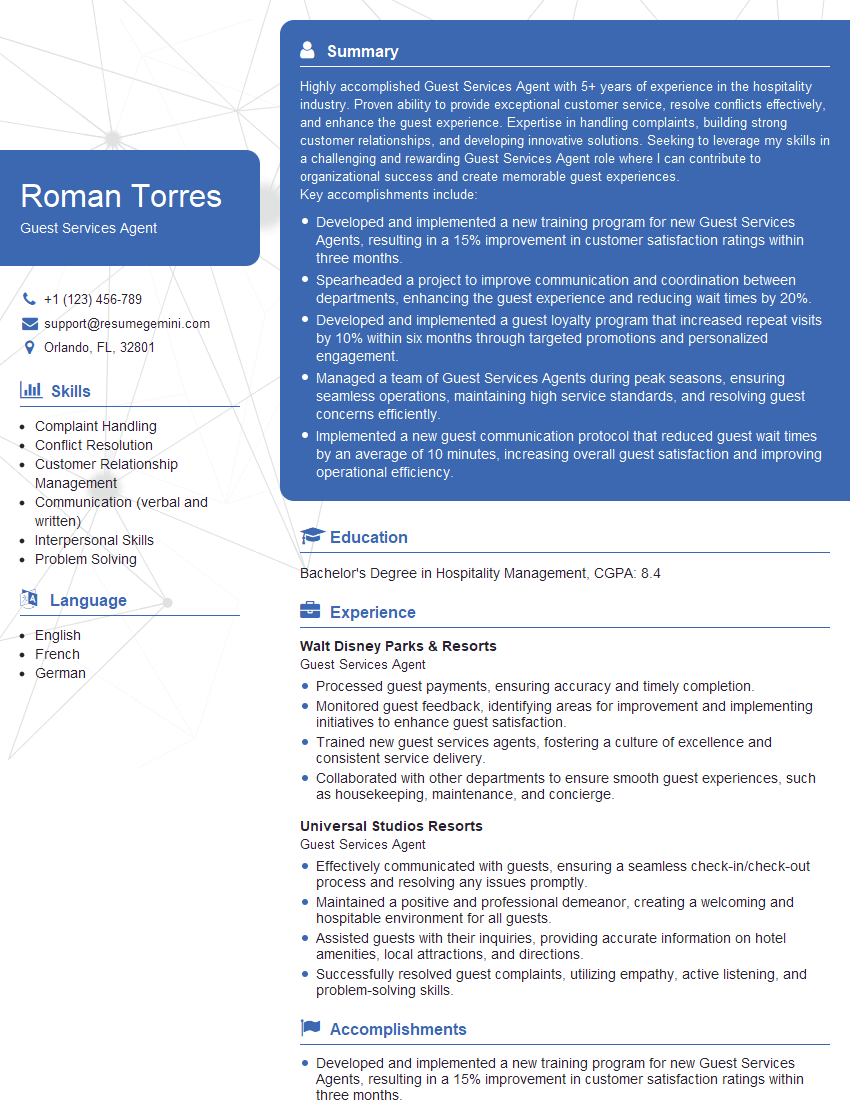Feeling uncertain about what to expect in your upcoming interview? We’ve got you covered! This blog highlights the most important Greeting Clients interview questions and provides actionable advice to help you stand out as the ideal candidate. Let’s pave the way for your success.
Questions Asked in Greeting Clients Interview
Q 1. Describe your approach to greeting clients in a high-pressure environment.
Greeting clients in a high-pressure environment requires a calm and efficient approach. My strategy focuses on immediate acknowledgment and prioritization. I begin with a warm, yet concise greeting, acknowledging their presence and the urgency they may feel. For example, ‘Good morning, Mr. Jones, I understand you’re on a tight schedule; let’s get started immediately.’ This demonstrates respect for their time while setting a professional tone. Simultaneously, I assess the situation, quickly identifying their primary need to determine the most effective course of action. This may involve prioritizing their request, redirecting them to the appropriate resource if necessary, or providing a clear timeline for resolution. Maintaining a confident and composed demeanor is key to diffusing any potential anxiety, ensuring the client feels assured that their needs will be met effectively.
I then utilize a system of prioritization based on urgency and impact. This might involve a quick mental checklist or a visual system like a Kanban board (if applicable to the setting) to track multiple clients’ requests and ensure everyone feels heard and attended to. The goal is to manage the pressure efficiently without sacrificing quality of service or creating unnecessary stress for the client.
Q 2. How do you handle a client who is upset or frustrated?
Handling an upset or frustrated client requires empathy, patience, and active listening. My approach starts with acknowledging their feelings: ‘Mr. Smith, I understand your frustration, and I want to help resolve this.’ This validates their emotions without necessarily agreeing with their perspective. I then actively listen to their concerns without interruption, allowing them to fully express their thoughts. This is crucial for understanding the root cause of their dissatisfaction. I then repeat their concerns to ensure I’ve understood correctly – this shows I’m paying attention and reduces misunderstandings. Once I fully grasp the situation, I provide a clear, concise plan of action, outlining what steps I’ll take to resolve their issue. I set realistic expectations for resolution and keep them updated throughout the process. Regular communication is key to maintaining their trust and reducing their frustration.
For example, if a client is upset about a delayed order, I wouldn’t simply apologize; I’d explain the reason for the delay, offer a solution (like expedited shipping or a discount), and provide a clear timeline for when they can expect the order. This proactive approach demonstrates responsibility and commitment to customer satisfaction.
Q 3. Explain your process for identifying and addressing a client’s needs.
Identifying and addressing a client’s needs is a multi-step process that begins with careful observation and active listening. I start by paying attention to both their verbal and non-verbal cues. What is their immediate need? What are their underlying concerns? This initial observation helps me gauge the situation and prioritize their requests. I use open-ended questions to encourage them to elaborate: ‘Can you tell me more about what you’re looking for?’ or ‘What are your primary goals?’ This avoids leading questions and allows them to fully express their requirements. I then summarize their needs to ensure clarity and avoid any misunderstandings. Once I have a clear understanding of their needs, I present tailored solutions and options that address those specific needs, considering their budget and timelines. This personalized approach demonstrates that I’m attentive and committed to providing the best possible service.
For instance, if a client is vague about their needs, I’ll ask probing questions to clarify: ‘Are you looking for a quick solution or a long-term strategy?’ or ‘What is your budget for this project?’ This ensures we’re both on the same page and prevents wasted time and resources.
Q 4. How do you maintain a professional demeanor while dealing with difficult clients?
Maintaining professionalism with difficult clients is paramount. My approach involves remaining calm, respectful, and empathetic even in the face of negativity. I actively listen to their concerns without interrupting, even if their tone is aggressive or their language inappropriate. I use neutral body language; avoiding defensive postures or mirroring their negative energy. I employ techniques such as mirroring their tone (without adopting their negativity) to show I’m actively engaged in understanding their perspective, and I consistently utilize phrases that reaffirm their importance as a client, like ‘I understand your concern,’ or ‘I’m here to help’. I focus on finding common ground and collaborative solutions, rather than engaging in arguments or becoming defensive. If a client’s behavior becomes abusive or unacceptable, I follow company protocol for handling such situations, escalating the issue to a supervisor if necessary, ensuring my safety and the safety of others. The goal is to de-escalate the situation and reach a resolution while maintaining my professional integrity.
Q 5. What strategies do you use to build rapport with clients quickly?
Building rapport quickly involves creating a connection based on trust and understanding. I start by making genuine eye contact and offering a warm, sincere greeting. I use their name throughout the interaction to personalize the experience and show respect. I aim to create a comfortable atmosphere by using active listening techniques, showing that I genuinely care about their needs. I find common ground by looking for shared interests or experiences, even if it’s something as simple as discussing the weather or a local event. This creates a friendly and approachable environment, breaking down any barriers that might exist. I make sure to listen carefully to understand their perspective and articulate my understanding of their needs. This helps establish credibility and foster trust. Sometimes a simple gesture, like offering a beverage, can help to create a relaxed atmosphere.
For instance, if a client mentions an interest in a particular sport, I might briefly mention my own connection to that sport, creating an instant point of commonality. The key is to be genuine and authentic.
Q 6. Describe a time you went above and beyond to provide exceptional client service.
One time, a client’s crucial presentation materials were lost due to a technical issue right before a major conference. The deadline was impossible to meet through normal channels. Seeing their extreme distress, I immediately sprang into action. I contacted our IT department to explore all possible recovery solutions, simultaneously working to locate alternative presentation formats. Although recovery attempts failed, I managed to reconstruct the key slides from memory-based notes I had taken during earlier conversations with the client, and by leveraging archived email exchanges. I worked late into the night to produce a streamlined but fully functional presentation. The next morning, I personally delivered the revised presentation, ensuring all the essential details were accounted for. The client was incredibly grateful. Their presentation was a success, and they sent a positive testimonial highlighting my dedication and problem-solving skills. This experience showed me the importance of going the extra mile and thinking outside the box to provide exceptional client service.
Q 7. How do you handle multiple client requests simultaneously?
Handling multiple client requests simultaneously requires organization and prioritization. My approach uses a combination of techniques: First, I use a task management system (like a to-do list or project management software) to organize incoming requests. I prioritize them based on urgency and importance. I use time-blocking to allocate specific time slots for addressing individual client needs. While working on one request, I maintain clear communication with other clients, providing updates and setting expectations on when I can address their needs. This avoids keeping them waiting indefinitely and maintains transparency. I frequently assess my workload and readjust priorities as needed. This dynamic approach ensures that I am effectively managing my time while ensuring all clients receive timely and adequate attention.
For example, I might dedicate 30 minutes to a high-priority request, then 15 minutes to respond to a few emails, and then return to the initial task, using a system of prioritization based on urgency and overall project timelines.
Q 8. How do you prioritize client requests based on urgency and importance?
Prioritizing client requests involves a balanced approach considering both urgency and importance. I use a system similar to the Eisenhower Matrix (Urgent/Important), categorizing requests into four quadrants:
- Urgent and Important: These require immediate attention. For example, a critical system failure reported by a major client falls here. I address these first.
- Important but Not Urgent: These are crucial for long-term success, such as strategic planning sessions with a key partner. I schedule these proactively.
- Urgent but Not Important: These often involve immediate but less critical tasks, like responding to a minor technical issue. I delegate where possible or address them efficiently to free up time for higher-priority items.
- Neither Urgent nor Important: These can often be delegated, postponed, or eliminated. For example, a request for information that’s already readily available online.
This system ensures that time is allocated effectively to the most impactful tasks, maintaining client satisfaction and preventing crisis management.
Q 9. How do you adapt your communication style to different types of clients?
Adapting my communication style is crucial for building strong client relationships. I tailor my approach based on factors like the client’s personality, communication preferences, and the context of the interaction. For example:
- Formal Clients: I use a professional and precise tone, sticking to business etiquette. I might prioritize email communication and detailed reports.
- Informal Clients: I might use a more conversational style, potentially incorporating humor or casual language, depending on their comfort level. Quick phone calls or instant messaging might be preferred.
- Tech-Savvy Clients: I leverage technology to enhance communication, such as using project management software or video conferencing.
- Less Tech-Savvy Clients: I might rely on more traditional methods, like phone calls or detailed written instructions. I ensure communication is clear and easy to understand.
Active listening is key throughout – I pay close attention to the client’s verbal and non-verbal cues to ensure I’m effectively communicating and addressing their needs.
Q 10. How do you ensure client confidentiality?
Client confidentiality is paramount. I adhere to strict protocols to safeguard sensitive information. This includes:
- Data Encryption: I utilize secure systems and encryption methods to protect client data both in transit and at rest.
- Access Control: Access to client information is strictly limited to authorized personnel on a need-to-know basis. This is enforced through role-based access control systems.
- Data Minimization: I only collect and retain the minimum necessary client data.
- Compliance: I follow all relevant data privacy regulations, like GDPR and CCPA.
- Confidentiality Agreements: Where appropriate, I use Non-Disclosure Agreements (NDAs) to formally protect sensitive information.
I understand that breaches of confidentiality can have serious consequences, and I take every precaution to prevent them.
Q 11. How do you use technology to enhance client interaction?
Technology significantly enhances client interaction. I utilize various tools to improve communication, collaboration, and service delivery:
- CRM Software: Provides a centralized platform to manage client interactions, track requests, and analyze data.
- Project Management Software: Facilitates collaboration on projects and tasks, enabling transparent progress updates and efficient communication.
- Video Conferencing: Allows for face-to-face communication, enhancing engagement and building rapport.
- Email Marketing Platforms: Streamlines mass communication for updates and announcements.
- Live Chat Support: Offers immediate assistance and resolves queries quickly.
By integrating these technologies, I ensure seamless communication and enhance the overall client experience.
Q 12. How do you handle client complaints effectively?
Handling client complaints requires empathy, professionalism, and a solution-oriented approach. My process involves:
- Active Listening: I let the client fully express their concerns without interruption.
- Empathy and Validation: I acknowledge their frustration and validate their feelings.
- Understanding the Issue: I ask clarifying questions to understand the root cause of the complaint.
- Finding a Solution: I propose solutions and work with the client to reach a mutually agreeable resolution. This might involve offering compensation, making improvements to the service, or providing an alternative solution.
- Following Up: I follow up with the client after the issue is resolved to ensure their satisfaction.
Turning a negative experience into a positive one can strengthen client loyalty. A well-handled complaint demonstrates a commitment to client satisfaction.
Q 13. Describe your experience using CRM software to manage client interactions.
I have extensive experience using CRM software, primarily Salesforce and HubSpot. I use these tools to:
- Manage Contacts: Centralize client information, including contact details, communication history, and interactions.
- Track Interactions: Record all communications, such as emails, calls, and meetings, to maintain a comprehensive history.
- Manage Tasks and Follow-ups: Set reminders for follow-up actions and track progress on client requests.
- Generate Reports: Analyze client data to identify trends, improve service delivery, and enhance client relationships.
- Automate Processes: Automate routine tasks, like sending welcome emails or follow-up reminders, increasing efficiency.
Example: Using Salesforce, I can create custom reports to track client satisfaction scores based on survey responses, helping to identify areas for improvement.
Q 14. How do you track and follow up on client requests?
Tracking and following up on client requests is crucial for maintaining efficient workflows and client satisfaction. I use a multi-pronged approach:
- Centralized System: I utilize CRM software or project management tools to log all requests, assigning them priorities and deadlines.
- Automated Reminders: I set reminders for myself and relevant team members to ensure timely follow-up.
- Regular Check-ins: I schedule regular check-in calls or emails with clients to provide updates and address any concerns.
- Documentation: I meticulously document all actions taken on each request, maintaining transparency and traceability.
- Client Feedback: I actively solicit client feedback to assess the effectiveness of my follow-up strategies.
This systematic approach ensures nothing slips through the cracks and fosters strong, reliable client relationships.
Q 15. How do you gather client feedback and use it to improve service?
Gathering client feedback is crucial for continuous improvement. I employ a multi-faceted approach, combining various methods to capture a holistic view. This includes:
- Post-interaction surveys: Short, targeted surveys sent via email or SMS immediately following an interaction, focusing on specific aspects like efficiency and satisfaction.
- Feedback forms: Printed forms available at physical locations or online forms accessible through a QR code, allowing for more detailed feedback.
- Regular check-in calls: Proactive calls to clients to discuss their overall experience and identify areas for enhancement. This fosters a personal connection and encourages candid feedback.
- Social media monitoring: Actively monitoring online reviews and social media mentions to identify both positive and negative comments, allowing for quick responses and issue resolution.
Once collected, feedback is analyzed to identify recurring themes and trends. For example, if multiple clients mention difficulty navigating a specific section of the website, that becomes a priority for improvement. This data-driven approach ensures that improvements are focused on the areas impacting the majority of clients and are targeted for maximum effectiveness.
Career Expert Tips:
- Ace those interviews! Prepare effectively by reviewing the Top 50 Most Common Interview Questions on ResumeGemini.
- Navigate your job search with confidence! Explore a wide range of Career Tips on ResumeGemini. Learn about common challenges and recommendations to overcome them.
- Craft the perfect resume! Master the Art of Resume Writing with ResumeGemini’s guide. Showcase your unique qualifications and achievements effectively.
- Don’t miss out on holiday savings! Build your dream resume with ResumeGemini’s ATS optimized templates.
Q 16. What metrics do you use to measure the success of client interactions?
Measuring the success of client interactions involves tracking several key metrics, including:
- Client Satisfaction (CSAT) scores: Measured through surveys, these scores directly reflect client happiness with the interaction.
- Net Promoter Score (NPS): This metric assesses the likelihood of clients recommending the service. A high NPS indicates strong client loyalty and positive word-of-mouth referrals.
- First Call Resolution (FCR): This measures the percentage of client issues resolved during the initial interaction. High FCR rates indicate efficiency and effectiveness.
- Average Handling Time (AHT): While efficiency is important, a balanced approach is key. A low AHT is desirable, but not at the expense of client satisfaction.
- Customer Effort Score (CES): This measures how easy it was for the client to interact with the service. A low effort score is indicative of a smooth and efficient experience.
By regularly monitoring these metrics, we can identify trends, pinpoint areas for improvement, and track the effectiveness of implemented changes. For instance, a low CSAT score might highlight the need for additional training on a specific product or process.
Q 17. How do you handle sensitive client information?
Handling sensitive client information requires strict adherence to data privacy regulations and best practices. This includes:
- Confidentiality agreements: Ensuring all team members sign confidentiality agreements to protect client data.
- Secure data storage: Utilizing encrypted databases and secure file storage systems to prevent unauthorized access.
- Access control: Implementing role-based access control to limit access to sensitive information only to authorized personnel.
- Data encryption: Encrypting all client data both in transit and at rest to safeguard against potential breaches.
- Regular security audits: Conducting periodic security audits to identify and address vulnerabilities.
- Employee training: Providing regular training to employees on data privacy policies and procedures.
For example, client financial information would be stored in a separate, highly secured database, accessible only to authorized personnel with appropriate security clearances. Any breach protocol is well documented and practiced regularly.
Q 18. Describe your experience with conflict resolution in client interactions.
Conflict resolution is a critical skill in client interaction. My approach is based on active listening, empathy, and a collaborative problem-solving mindset. I follow these steps:
- Active listening: Carefully listen to the client’s concerns without interruption, showing genuine empathy and understanding.
- Empathetic understanding: Acknowledge the client’s feelings and perspective, even if I don’t agree with their point of view.
- Collaborative problem-solving: Work together with the client to identify the root cause of the conflict and find mutually acceptable solutions.
- Clear communication: Clearly explain the solutions and next steps, ensuring the client understands and agrees.
- Follow-up: Follow up with the client after the conflict is resolved to ensure their satisfaction and prevent future issues.
For instance, if a client is upset about a delayed delivery, I would first apologize for the inconvenience, then explain the reason for the delay and offer a suitable solution like expedited shipping or a partial refund. The goal is always to leave the client feeling heard, understood, and valued.
Q 19. How do you maintain a positive attitude when dealing with challenging clients?
Maintaining a positive attitude with challenging clients requires patience, emotional intelligence, and a proactive approach. I utilize several strategies:
- Empathy and understanding: Putting myself in the client’s shoes, recognizing that their frustration is often rooted in unmet needs or expectations.
- De-escalation techniques: Using calm and reassuring language, avoiding confrontational responses, and actively listening to understand their concerns.
- Positive self-talk: Maintaining a positive internal dialogue to prevent negative emotions from impacting interactions.
- Taking breaks when needed: Stepping away from the interaction briefly if necessary to regain composure and approach the situation with a fresh perspective.
- Focusing on solutions: Shifting the focus from the problem to finding effective solutions that satisfy the client.
Remember, a client’s negative attitude is rarely personal. Focusing on resolving the issue at hand while demonstrating empathy and professionalism typically results in a positive outcome.
Q 20. How do you ensure client satisfaction?
Ensuring client satisfaction is a continuous process built on proactive engagement and responsive service. Key strategies include:
- Exceeding expectations: Consistently exceeding client expectations by offering exceptional service and going the extra mile.
- Proactive communication: Keeping clients informed about the status of their requests and proactively addressing potential issues.
- Personalized service: Providing personalized service that caters to individual client needs and preferences.
- Prompt and efficient service: Addressing client inquiries and resolving issues in a timely and efficient manner.
- Follow-up: Following up with clients after interactions to ensure their satisfaction and address any remaining concerns.
For example, sending a thank-you note after a significant interaction, or offering a small gift for their loyalty shows the client they are valued.
Q 21. What are your strengths and weaknesses in client interaction?
My strengths in client interaction include my excellent communication skills, empathy, and problem-solving abilities. I am adept at building rapport, actively listening to understand client needs, and finding creative solutions to complex issues. I am also highly organized and efficient, ensuring timely resolution of inquiries.
One area for development is managing my time when dealing with a high volume of inquiries. While I prioritize tasks effectively, I aim to further improve my time management skills to ensure optimal efficiency, even under pressure. I actively participate in continuing education to refine this skill and enhance my overall service delivery.
Q 22. How do you stay updated on client communication best practices?
Staying current with client communication best practices is crucial for providing excellent service. I achieve this through a multi-pronged approach.
Industry Publications and Blogs: I regularly read industry publications and blogs focusing on customer service, communication strategies, and relevant trends. This keeps me informed about new techniques and emerging technologies.
Professional Development Courses: I actively participate in webinars and workshops on effective communication, conflict resolution, and customer relationship management (CRM). These provide structured learning and opportunities for skill enhancement.
Networking and Conferences: Attending industry conferences and networking events allows me to learn from other professionals, share best practices, and stay abreast of the latest advancements.
Internal Resources: I leverage our company’s internal training materials, knowledge bases, and communication guidelines. This ensures I’m aligned with our company’s communication standards and best practices.
For example, recently I attended a webinar on using AI-powered chatbots to improve customer response times, and I’ve started experimenting with integrating that into my workflow.
Q 23. How do you handle situations where you cannot immediately fulfill a client request?
When I cannot immediately fulfill a client request, transparency and proactive communication are key. I never leave a client hanging. My approach involves these steps:
Acknowledge the Request: I immediately acknowledge the request, thanking the client for their patience. This shows that I’ve received their communication and value their business.
Provide a Realistic Timeline: I clearly explain why I cannot fulfill the request immediately and provide a realistic timeline for when I can address it. I avoid making promises I can’t keep.
Offer Updates: I proactively provide updates on the progress. This shows my commitment to the client and manages expectations. For example, I might send a quick email saying, “Hi [Client Name], just checking in on your request. I’m still working on gathering the necessary information and will get back to you by [Time/Date].”
Offer Alternative Solutions (if possible): If applicable, I suggest alternative solutions or temporary workarounds to mitigate the inconvenience. For example, if a specific feature is unavailable, I might suggest a similar feature or resource.
This process ensures that the client feels valued and informed, even if their request cannot be immediately fulfilled.
Q 24. Describe your experience with different communication channels (e.g., phone, email, chat).
I’m proficient in various communication channels and tailor my approach to the situation and client preference.
Phone: I find phone calls excellent for complex issues requiring immediate clarification and a more personal touch. I use a clear and concise tone, actively listen, and confirm understanding before ending the call.
Email: Email is best for documenting requests, providing detailed information, and preserving a record of communication. I aim for clear, concise emails with a professional tone and always proofread before sending.
Chat: Real-time chat is ideal for quick queries and immediate support. I maintain a friendly yet professional tone and use appropriate emojis to convey emotion where appropriate. I also ensure that I resolve the query efficiently and effectively within the chat environment.
For example, I recently used a combination of email and phone calls to assist a client with a complex technical issue, ensuring they felt understood and supported throughout the process.
Q 25. How do you personalize the client experience?
Personalizing the client experience involves going beyond standard greetings and actively engaging with clients on an individual level. I achieve this by:
Using Client’s Name: Addressing clients by their name creates a sense of familiarity and respect.
Remembering Details: I try to remember details from previous interactions, such as project specifics or personal preferences. For example, if a client previously mentioned an interest in a particular topic, I might subtly incorporate that into the conversation.
Tailoring Communication Style: I adapt my communication style to suit the individual client. Some clients prefer formal interactions, while others are more comfortable with a casual approach.
Proactive Communication: Instead of just reacting to client inquiries, I proactively reach out with relevant updates or information, showing that I’m invested in their success.
By remembering client preferences and consistently providing personalized support, I build stronger relationships and foster loyalty.
Q 26. Describe your experience with handling client inquiries involving multiple departments.
Handling client inquiries involving multiple departments requires excellent coordination and communication skills. My approach is as follows:
Gather All Necessary Information: I begin by carefully gathering all necessary information from the client, ensuring I fully understand their needs and concerns.
Identify the Relevant Departments: I determine which departments are involved in addressing the client’s inquiry.
Contact the Relevant Departments: I contact the appropriate individuals in each department, providing them with the necessary information and context.
Keep the Client Informed: I maintain clear communication with the client, providing updates on the progress and keeping them informed of any delays or challenges.
Follow Up: Once the issue is resolved, I follow up with the client to ensure their satisfaction.
This systematic approach ensures that the client’s inquiry is handled efficiently and effectively, minimizing confusion and delays.
Q 27. How do you handle situations with demanding or unreasonable clients?
Handling demanding or unreasonable clients requires patience, empathy, and a structured approach. My strategy focuses on de-escalation and finding solutions:
Active Listening and Empathy: I actively listen to the client’s concerns, demonstrating empathy and understanding, even if their behavior is challenging.
Remain Calm and Professional: I remain calm and professional, avoiding getting drawn into an argument.
Validate their Feelings: I acknowledge and validate their feelings, even if I don’t agree with their perspective. For example, “I understand your frustration,” or “I can see why you’re upset.”
Focus on Solutions: I focus on finding solutions to address the client’s concerns, even if it requires compromising.
Set Boundaries: If the client’s behavior is inappropriate or abusive, I will politely but firmly set boundaries, referring them to a supervisor if necessary.
My goal is to resolve the issue and maintain a professional relationship, even in difficult situations. Sometimes a simple apology can go a long way, even if it’s not entirely my fault.
Q 28. How do you measure your success in greeting and interacting with clients?
I measure my success in greeting and interacting with clients through several key metrics:
Client Satisfaction Surveys: These provide direct feedback on my performance and highlight areas for improvement.
Resolution Time: Reducing resolution times demonstrates efficiency and responsiveness.
Client Retention Rate: A high client retention rate indicates that I’m building strong, positive relationships.
Positive Feedback: Positive comments from clients, whether verbal or written, demonstrate that I am providing excellent service.
Repeat Business: Repeat business is a strong indicator of client satisfaction and loyalty.
By regularly monitoring these metrics, I can identify areas of strength and weakness, allowing me to continually refine my approach and provide the best possible client experience.
Key Topics to Learn for Greeting Clients Interview
- First Impressions: Mastering the art of creating a positive and professional first impression, both in person and remotely. Consider verbal and non-verbal communication techniques.
- Active Listening & Communication: Practical application of active listening skills to understand client needs and respond appropriately. Practice reflecting client statements and asking clarifying questions.
- Building Rapport: Techniques for establishing trust and connection with clients from diverse backgrounds. Explore strategies for adapting your communication style to individual client personalities.
- Handling Difficult Clients: Developing strategies for managing challenging interactions and de-escalating tense situations with professionalism and empathy. Role-playing can be particularly helpful here.
- Professionalism & Etiquette: Understanding and applying appropriate professional conduct, including phone etiquette, email etiquette, and in-person interaction best practices.
- Problem-Solving & Client Needs: Identifying and addressing client needs effectively and efficiently, offering solutions and resolving issues promptly and courteously. Consider different problem-solving frameworks.
- Company Culture & Brand Representation: Understanding your company’s values and brand identity to represent them accurately and positively when interacting with clients.
Next Steps
Mastering the art of greeting clients is crucial for career advancement in almost any customer-facing role. It directly impacts client satisfaction, retention, and overall company success. To significantly enhance your job prospects, focus on crafting an ATS-friendly resume that highlights your skills and experience in this area. ResumeGemini is a trusted resource that can help you build a professional and effective resume. We provide examples of resumes tailored to the specific needs of Greeting Clients roles to guide you through the process. Invest time in crafting a compelling resume – it’s your first impression on potential employers.
Explore more articles
Users Rating of Our Blogs
Share Your Experience
We value your feedback! Please rate our content and share your thoughts (optional).
What Readers Say About Our Blog
Hi, I’m Jay, we have a few potential clients that are interested in your services, thought you might be a good fit. I’d love to talk about the details, when do you have time to talk?
Best,
Jay
Founder | CEO






